Why did the church collapse? South African architect says he knows
News of a building collapse on another continent isn’t the kind of thing that normally sends people into a frenzy of activity.
But when Mike Bell, an architect in Cape Town, South Africa, heard about the fall of New London’s First Congregational Church, he knew instantly he had to determine the cause. It’s the same reaction he’s had to other disasters.
“My mind goes into overdrive,” he said. “When I see the photographs and I hear the witnesses talking and the sequences, my brain just must, must figure it out.”
Bell, 61, whose résumé includes the design of a 40,000-seat soccer stadium in South Africa built for the FIFA World Cup, is retired after a 35-year career. He now makes videos for YouTube in which he explains “complicated things in a simple manner with 3D animations for your enjoyment,” his bio reads.
With 58,000 subscribers, Bell has made videos on everything from a drone strike that killed the leader of al-Qaida to the implosion of a submersible exploring the Titanic. But he has a specialty.
“You really do need to have a niche, and building collapses totally are my niche,” he said. “There’s nobody else who does it and who can do what I do.”
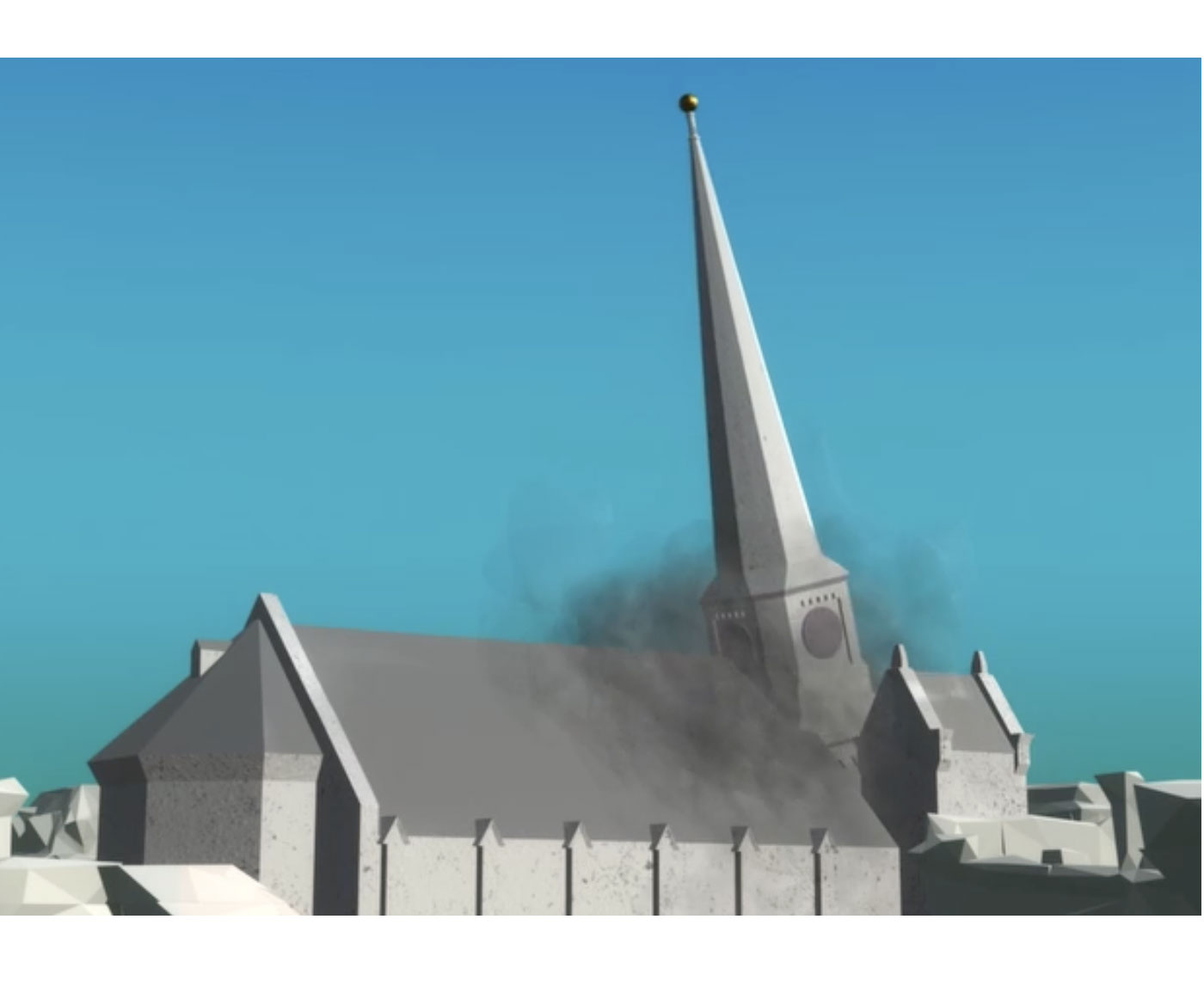
Mike Bell, a South African architect, used Blender, open-source 3D computer graphics software, to animate the Jan. 25 collapse of the First Congregational Church.
His recreation shows the towering granite spire falling inward through the roof of the building.
Graphics courtesy Mike Bell

Mike Bell, a South African architect, used Blender, open-source 3D computer graphics software, to animate the Jan. 25 collapse of the First Congregational Church.
His recreation shows the towering granite spire falling inward through the roof of the building.
Graphics courtesy Mike Bell
To figure out and animate collapses, he said, he bounces ideas off structural engineer friends and draws on a wealth of experience from his career.
“When you’re working for really, really long, you don’t even need to think,” he said. “If somebody asks you a question, it just sort of rolls off because you’ve done it so many times. … It’s an amazing place to get to.”
Solving New London’s church collapse, which happened Jan. 25, was right up his alley. When he heard about it online, “I immediately just went into every nook and cranny I could find, got everything I could, and within a day and a half I published the first video.”
Eight minutes long, it includes the widely seen security camera footage that gives a partial view of the collapse. He followed that up with a 16-minute video, released a week ago, that goes into more detail.
Though Bell worked on the second video for weeks, by the time the first one came out, he said, he had already figured out what brought the building down.
* * *
Officials in New London are still investigating the collapse and have not announced the cause. They have the advantage of being here, while Bell is an ocean away.
But in the internet age, distance has almost ceased to matter.
“If I could drive there and come and have a look for myself and take footage, that would be better,” Bell said, “but the distance actually is immaterial to me.”
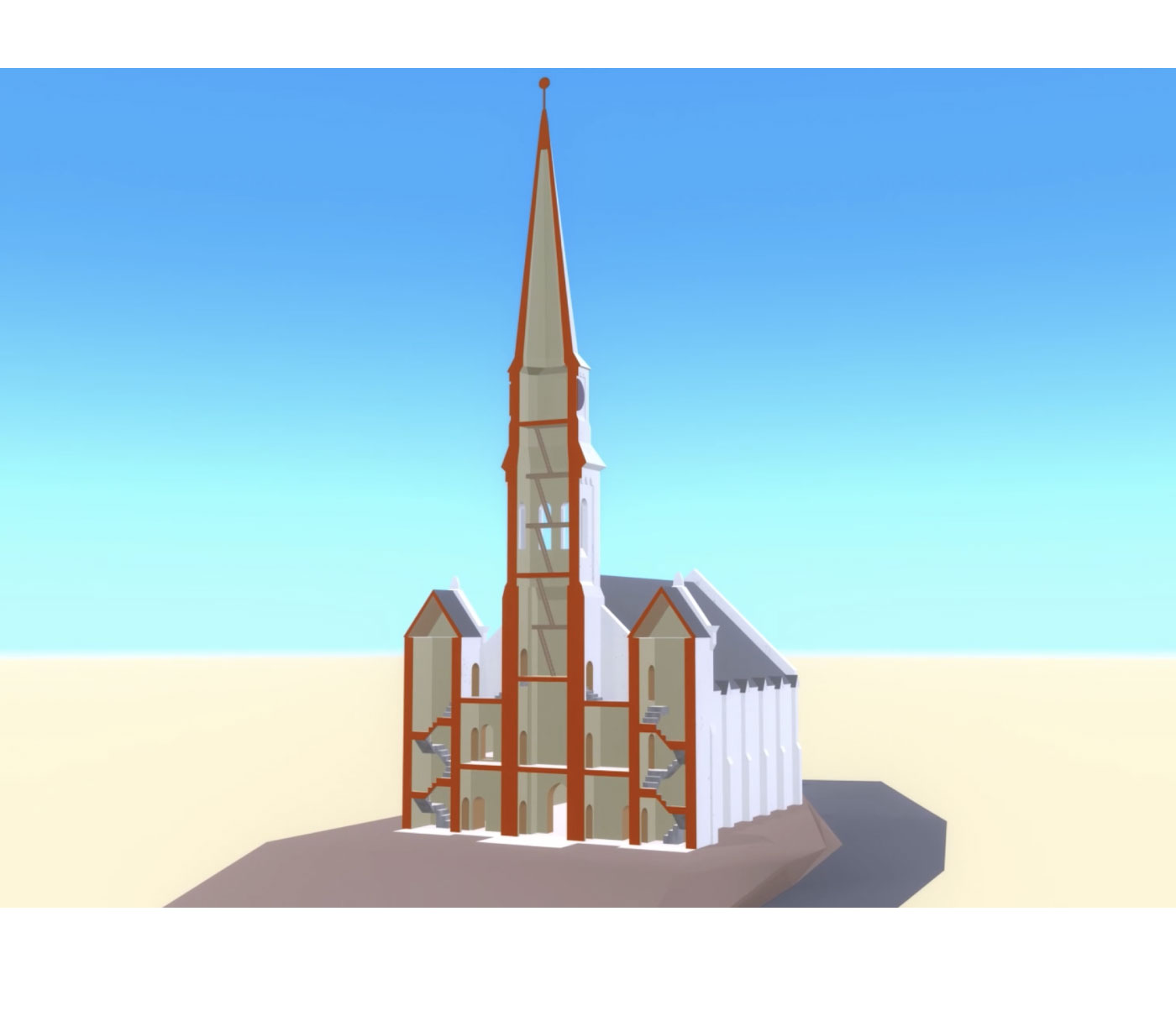
A cutaway view of the front of the church and the center spire. If Bell’s theory is correct, the seeds of the church’s demise were planted at its birth.
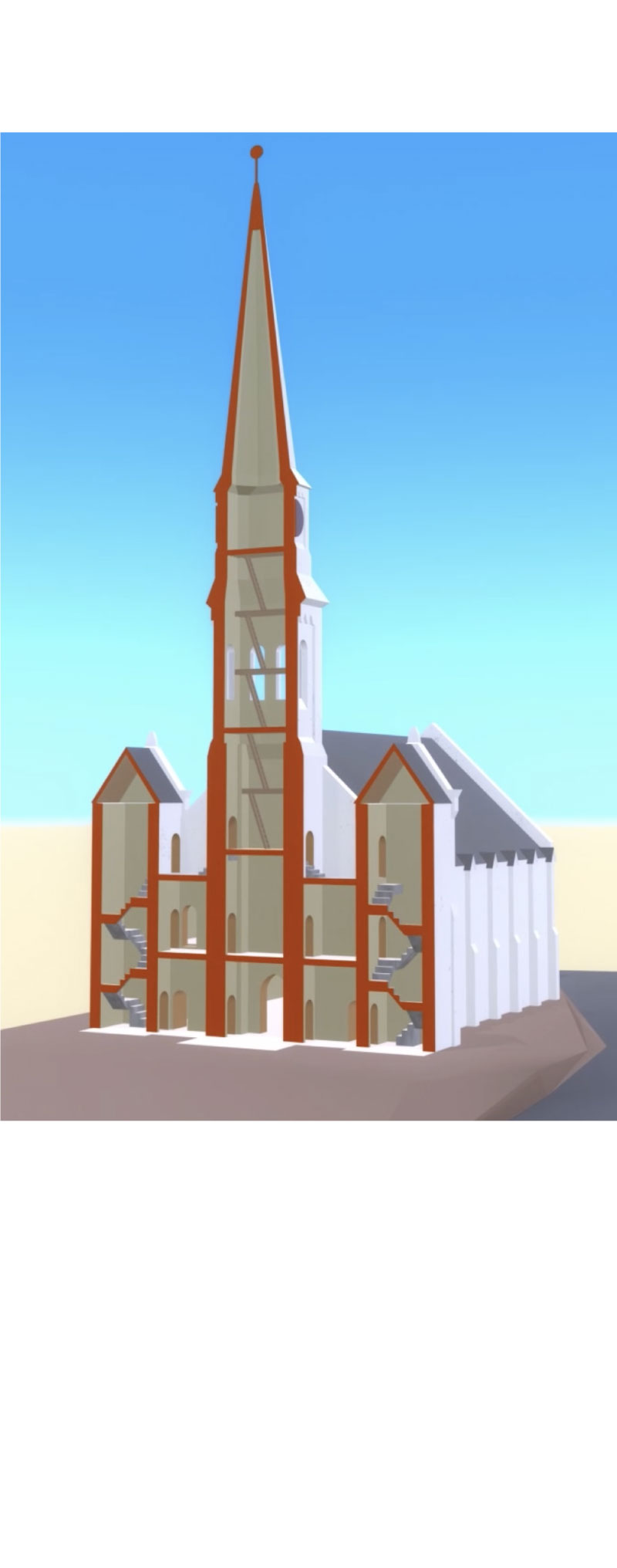
A cutaway view of the front of the church and the center spire. If Bell’s theory is correct, the seeds of the church’s demise were planted at its birth.
The information he consulted is much of what would be available if he were here: the footage from the ISAAC School, which caught the spire’s fall; the most recent report on the building’s condition; drone video; photographs; and news stories, including those in The Day, to which he bought a subscription.
Most of what he needed was at his fingertips, and he found more by connecting with people via email and social media.
“The internet is absolutely phenomenal,” Bell said. “There was a plane crash in Nepal a year ago, and within no time at all I had spoken to the guy who happened to be filming the crash from his balcony, which was key to my video.” He found the man by messaging him on TikTok.
Getting a video online promptly is important, he said, because YouTube’s algorithm sends more viewers his way when a story is fresh. His second video about the church was delayed while he hurried to complete an animation of the Francis Scott Key Bridge collapse in Baltimore.
Still, of over 90,000 people who viewed his “quick response” church video in January, only about 100 were in the New London area. For some reason, his effort didn’t catch on here, even though he explained in detail how and why the building failed.
* * *
So what happened?
“It was pretty obvious from the clues,” Bell said. “There was a bad pocket of masonry,” which he called “a ticking time bomb.”
He said he pinpointed the location to the steeple’s north wall behind the balcony. There were reports of a serious water leak and buckling door frames at the spot, which is where the pipe organ was.
“That’s part of my theory,” he said, “that the organ might have covered up the damage.”
The organ was replaced with a digital one around 2011 because of the leak, said Alan McNeely, whose Waterford company maintained the instrument. But the larger pipes and oak casework were there until the end.
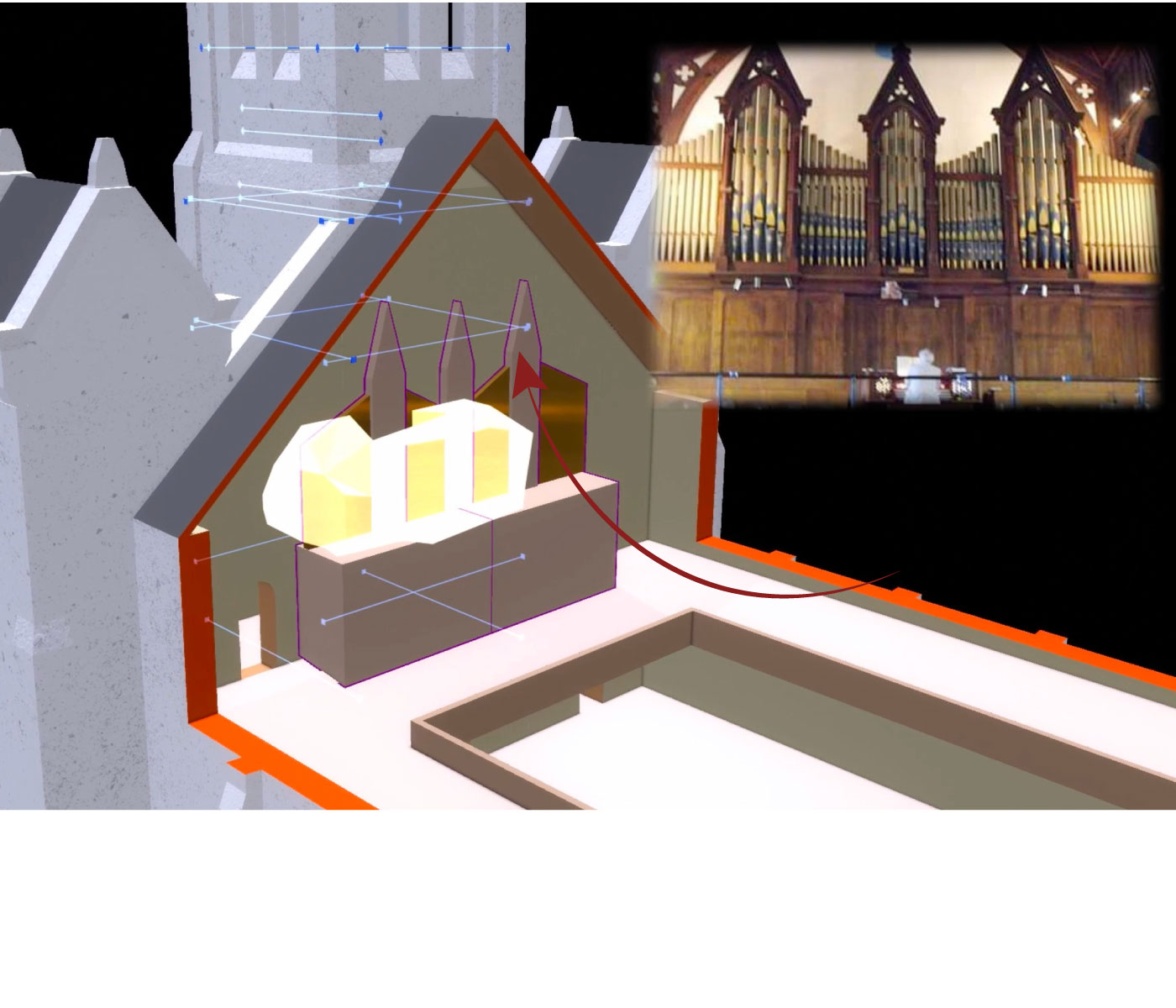
The organ, shown in photo above, is outlined in magenta.
Bell believes a pocket of bad masonry was the cause of the spire’s tilt and its eventual collapse. He says it was in the steeple’s north wall, shown in white, and may have been hidden by the church’s pipe organ.
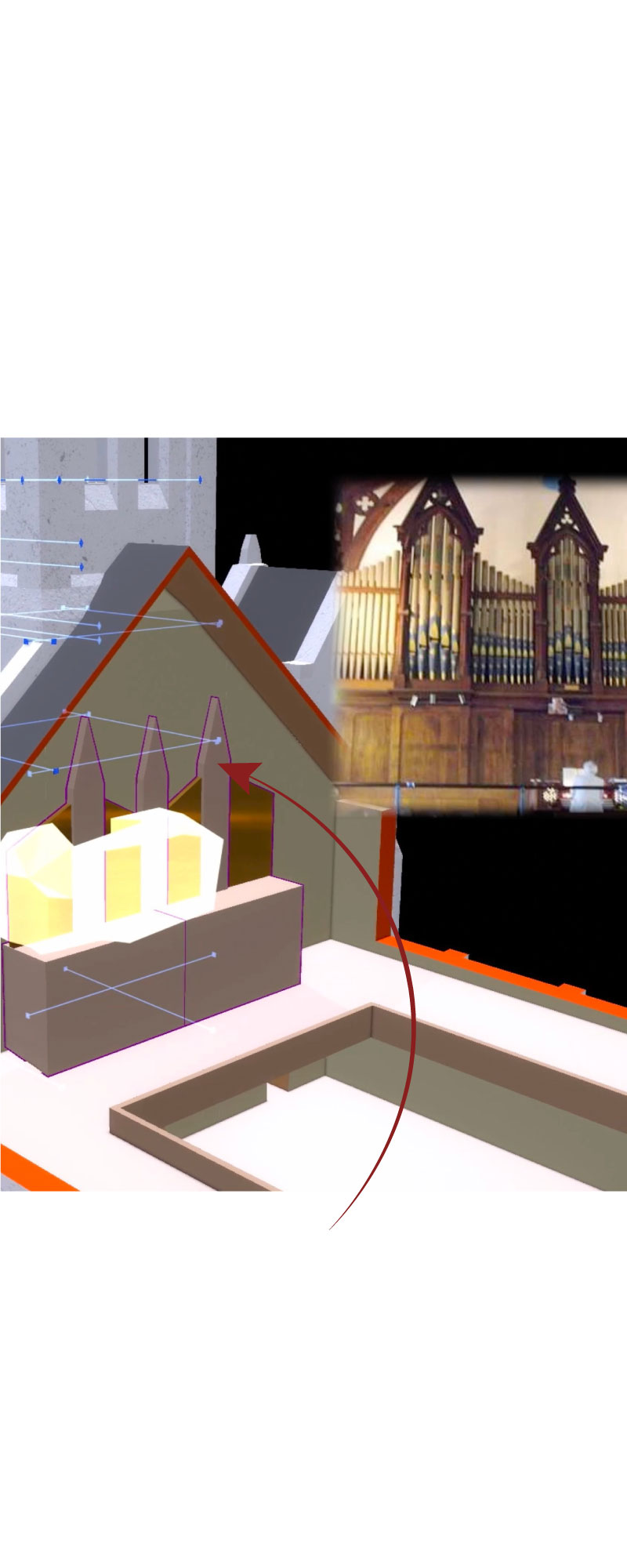
Bell believes a pocket of bad masonry was the cause of the spire’s tilt and its eventual collapse. He says it was in the steeple’s north wall, shown in white, and may have been hidden by the church’s pipe organ.
The pipe organ, shown in photo above, is outlined in magenta in Bell’s graphic.
If true, Bell’s theory would be part of a remarkable story. Because, he said, the masonry’s poor condition wasn’t anything recent. It dated all the way back to the church’s construction in 1850-51.
As The Day has reported, Leopold Eidlitz, the church’s architect, wrote a letter of warning to the congregation as soon as the building was occupied. He said the tower walls were parting “in consequence of defective masonry and unequal settling.”
Eidlitz decided to “secure the tower with iron anchors” as a temporary solution, and the church arranged for permanent repairs in 1857, though Eidlitz had recommended the tower be demolished and rebuilt.
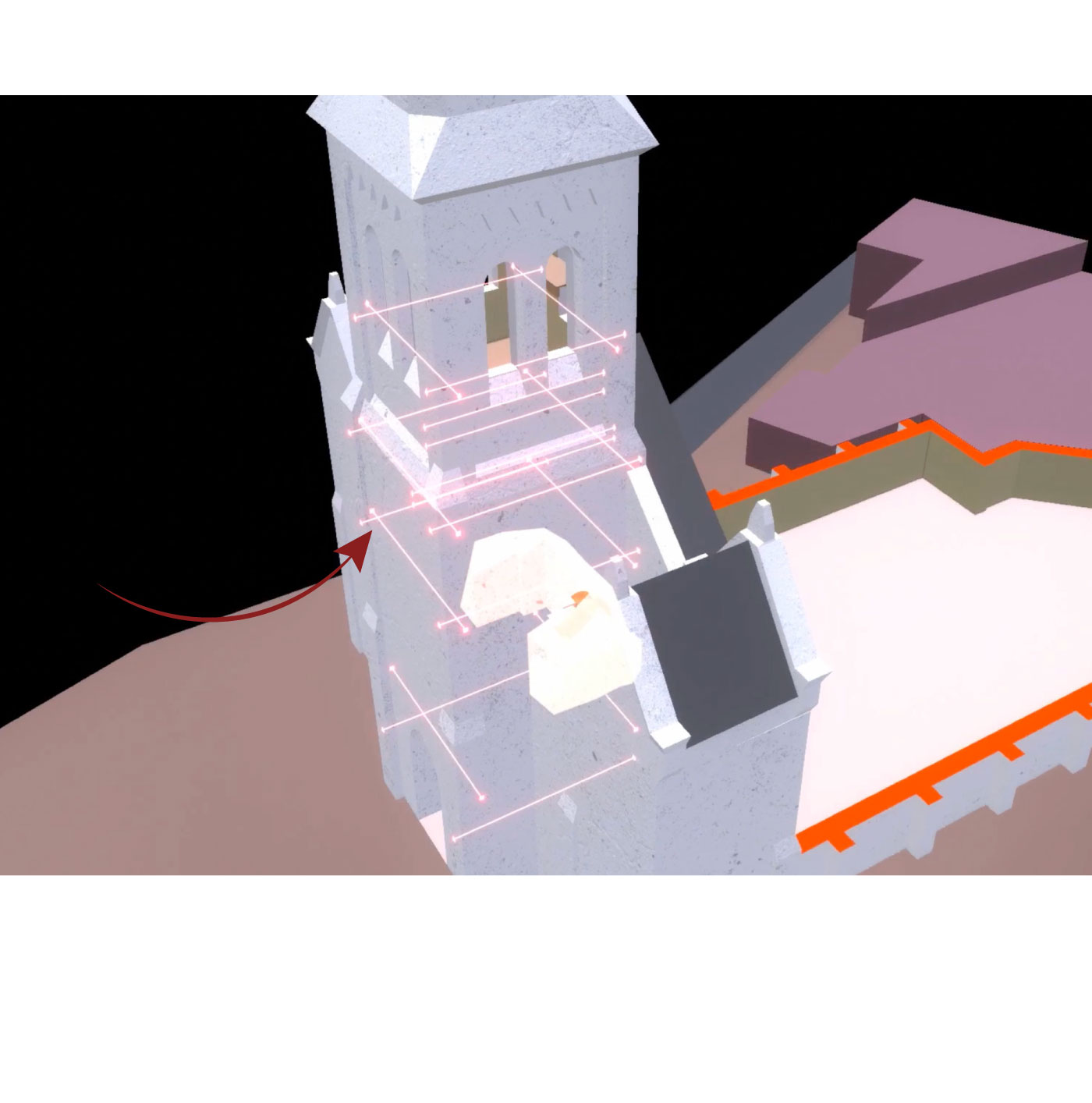
Steel rods called anchor ties were installed in the spire shortly after the church was completed to hold it together because the walls were already parting.
The church’s architect said the tower walls were unstable because of defective masonry and uneven settling. He wanted the tower demolished and rebuilt.
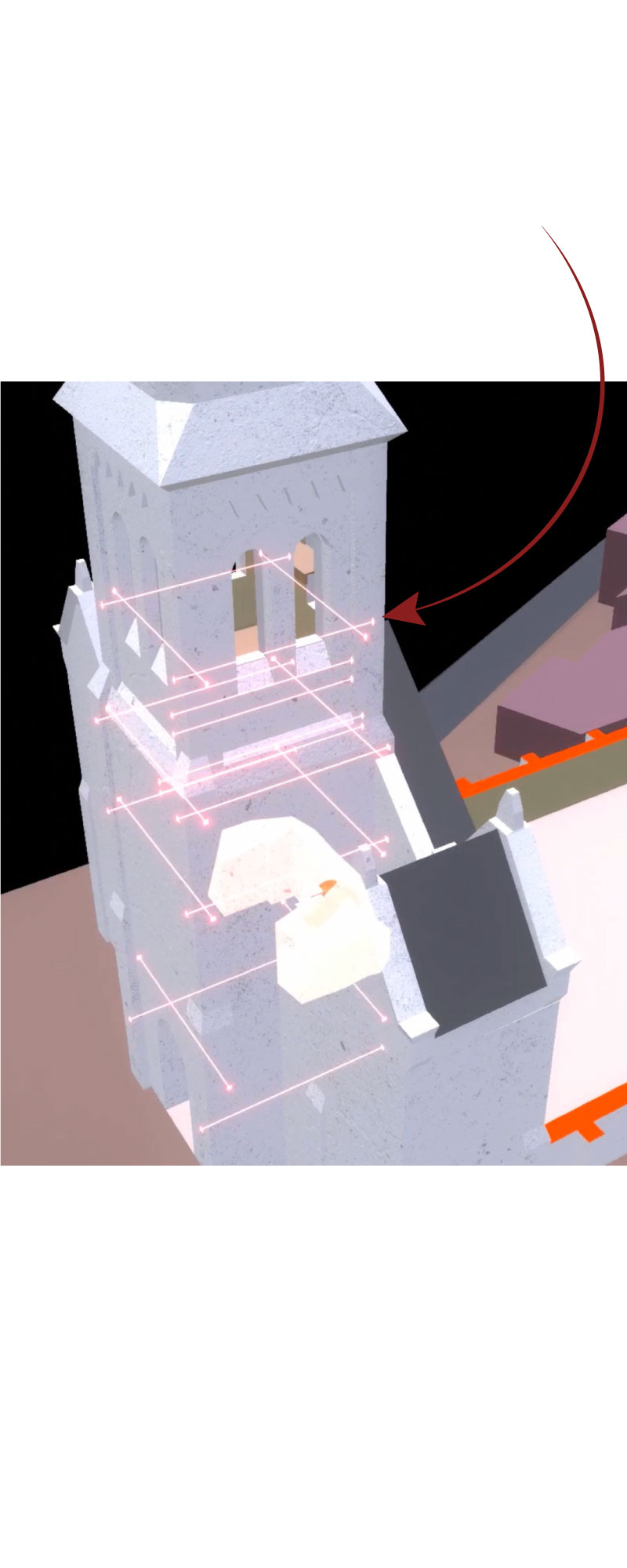
Steel rods called anchor ties were installed in the spire shortly after the church was completed to hold it together because the walls were already parting.
The church’s architect said the tower walls were unstable because of defective masonry and uneven settling. He wanted the tower demolished and rebuilt.
The unequal settling produced a problem that was hiding in plain sight. The church’s granite spire, 150 feet high, was left with a slight but significant tilt, Bell said. The tilt, which was toward the rest of the building, began around the apex of the roof, below the bell room, and was probably there from the beginning, he said.
Bell noted that the church survived the 1938 hurricane, a Category 3 storm, which suggests the masonry pocket degraded considerably after that. The rest of the building was solidly built, he said.
The spire’s tilt was stable until around 2019, when photos show it started to worsen. By Jan. 25, it had increased to 2 degrees, shifting the weight of the spire to the damaged north wall. When the wall’s bearing capacity was exceeded, he said, the whole thing collapsed.
New London Fire Marshal Vernon Skau, who is coordinating the official investigation, declined to provide any details about its focus and did not indicate when it would be finished.
* * *
Bell’s main evidence was the ISAAC footage: not just the five seconds everyone has seen, but 24 minutes of high-resolution video that allowed him to track the tilt frame-by-frame. The school, which supplied the video, also gave him still images for the prior 10 days.
“Video is super, super valuable to me, or photographs as well, but video is the best,” he said.
In the ISAAC footage, only the spire is visible over the parking garage on Governor Winthrop Boulevard. But Bell used Blender, open-source 3D computer graphics software, to model the entire event. Blender helped Bell document the tilt, as did a 2014 photo and 3D views of downtown New London from 2019 on Google Maps.
As the tilt worsens in the footage, the spire pivots on a point near the roof line, suggesting that the damage is just below that, around the balcony.
In his second video, Bell tracked the gilded ball atop the spire, where the tilt’s increase was most evident. The ball’s movement grew exponentially: 15 inches in the last four years, another 17 inches in the 10 days before the collapse, 7 more inches in the final 24 minutes, and 19 inches in the 1.7 seconds before the spire reached its tipping point.
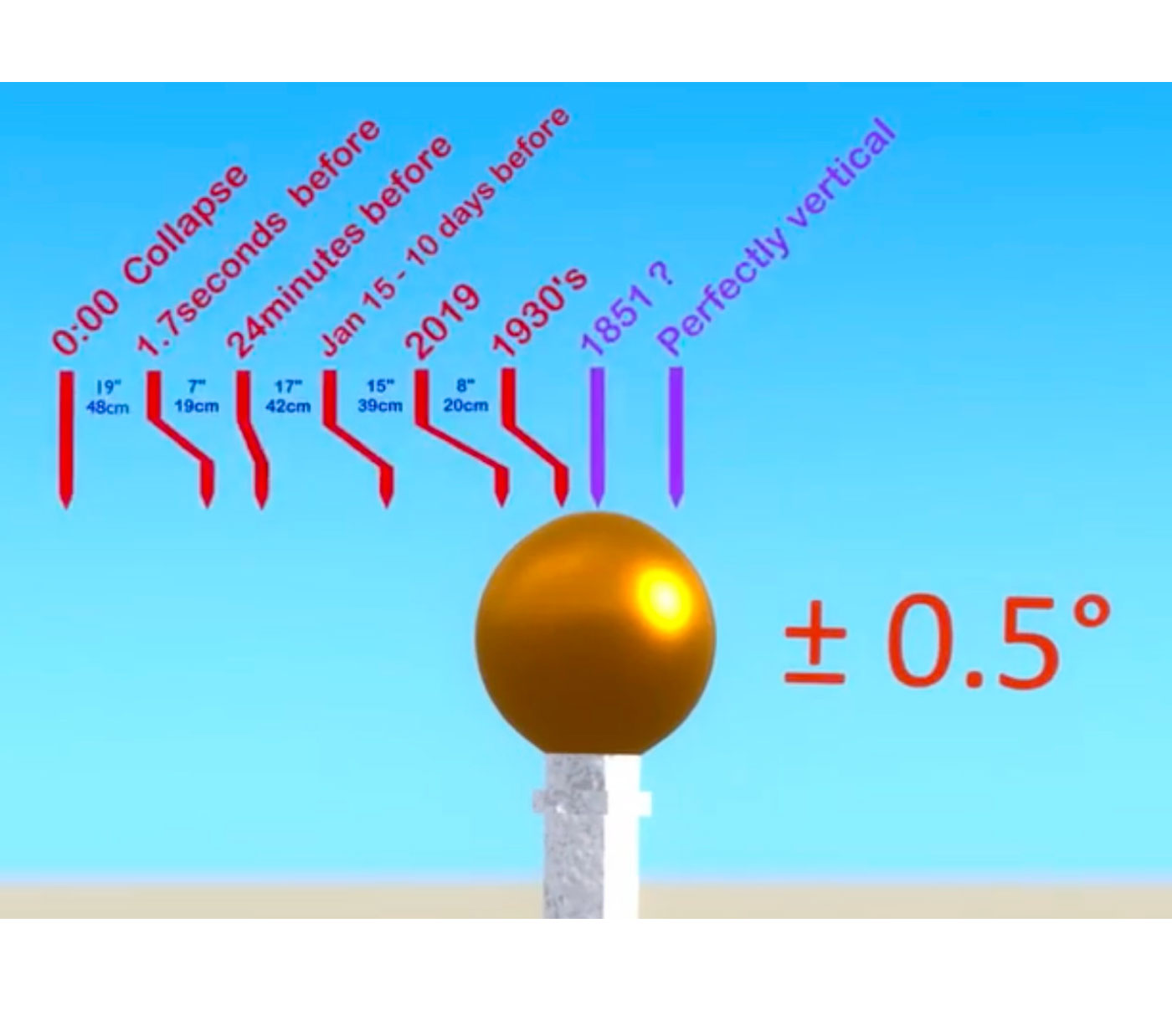
Using video and photo evidence, Bell tracked the movement of the gilded ball atop the spire. The tilt worsened dramatically in the days before the collapse.
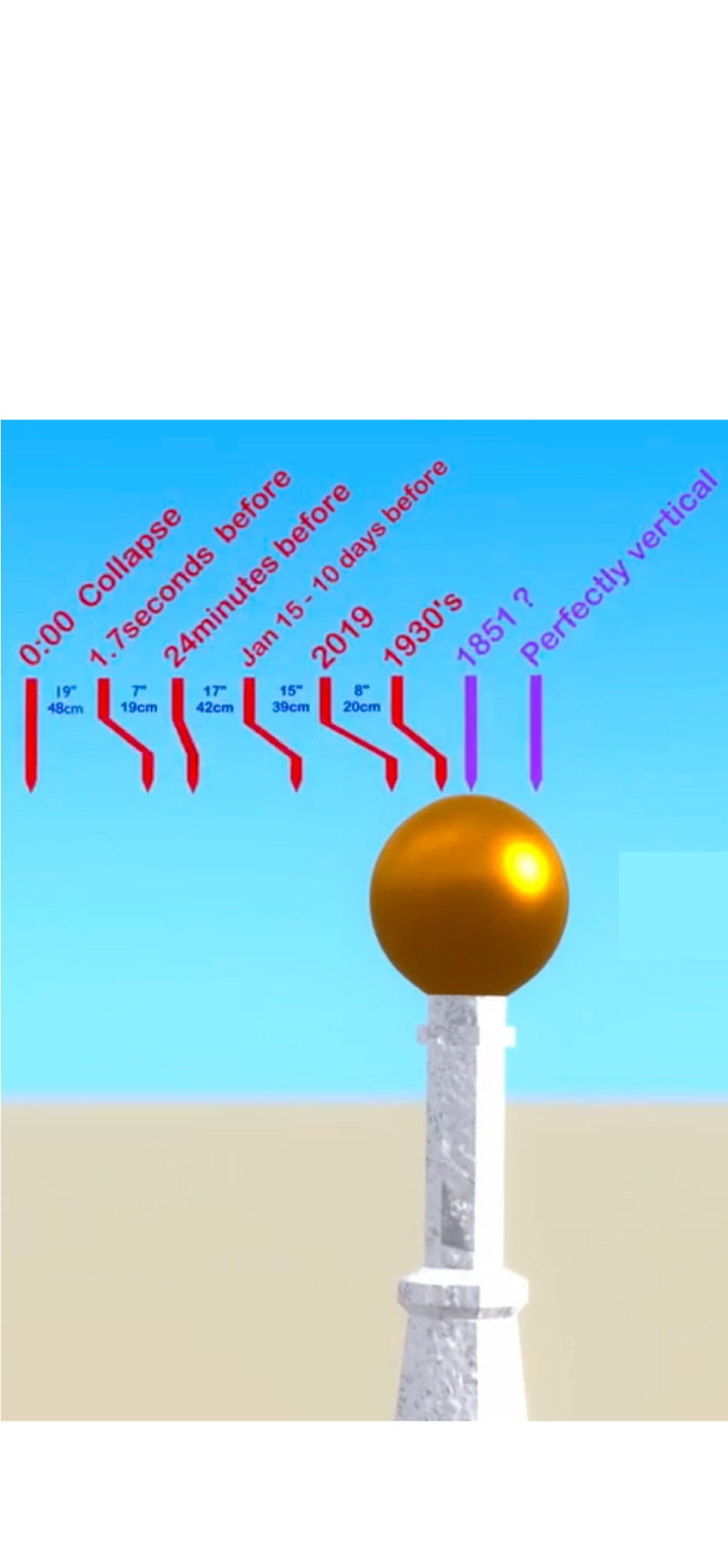
Using video and photo evidence, Bell tracked the movement of the gilded ball atop the spire. The tilt worsened dramatically in the days before the collapse.
As the spire began to fall, it built up momentum that increased its weight, creating a “hammer blow effect” that overwhelmed solid stonework at the steeple’s base, he said. Then, the rest landed on the rubble, slowing the fall and causing the top of the spire to break off, a key moment in the ISAAC footage.
The spire fell through the roof while the lower steeple spilled onto the church’s lawn.
Photos of the church at different periods were also available, some of them supplied by The Day. They showed a sag in the roof where it met the steeple on the east side, but the steeple fell asymmetrically on the west side, he said.
A photo from the 1860s shows the building’s facade studded with “anchor plates,” where steel rods, or “ties," stabilizing the tower from within are bolted to the outer walls. This was a common corrective measure in older buildings, Bell said, and it’s possible one rusted through, contributing to the collapse.
The anchor plates, apparently from Eidlitz’s repairs and the church’s slightly later ones, look the same in recent photos.
“Nobody’s added any more,” he said, “which means if they added those anchor ties as the building was being completed, that masonry was indeed trouble.”
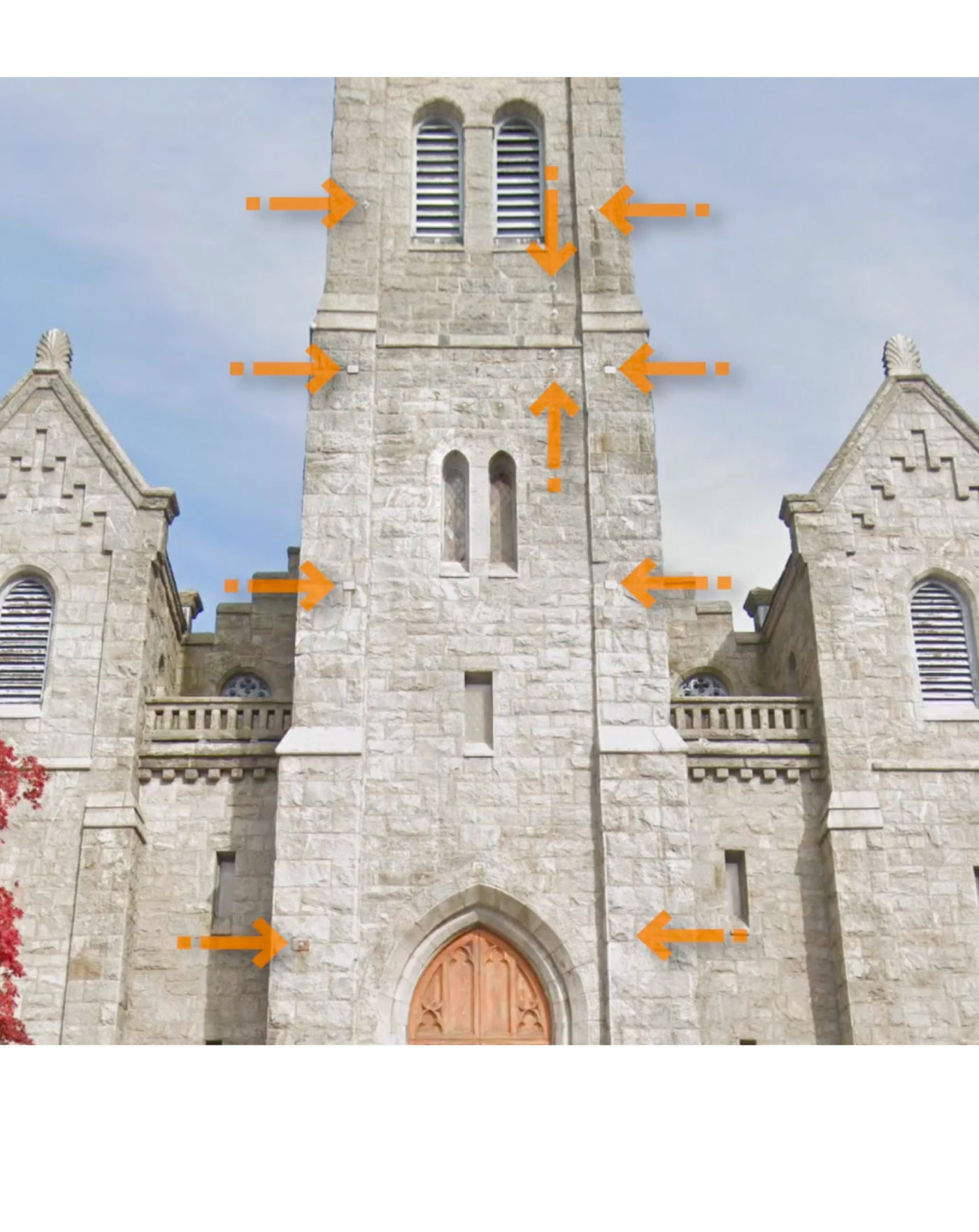
The steel tie rods were bolted to the outer walls with anchor plates, which were visible on the facade of the building.

The steel tie rods were bolted to the outer walls with anchor plates, which were visible on the facade of the building.
* * *
If Bell’s theory is correct, the seeds of the church’s demise were planted at its birth. Then it somehow survived until a random January day more than a century and a half later. He said for a flawed structure to last that long is rare.
“The architect would have been incredibly surprised that it took 175 years for it to fall down,” he said.
In his letter to the church, Eidlitz said the steeple had been built in a hurry by a contractor of questionable competence.
“To write a strong letter like that is professionally very brave,” Bell said, noting that Eidlitz was young at the time. “You can potentially lose future work if you get a name for being an alarmist. But at the same time, you’ve got to be professionally responsible and call out stuff that should be called out.”
Bell criticized what he said was a failure to call something out more recently. In 2011 the building’s condition was analyzed by Silver/Petrucelli + Associates, an architectural and engineering firm in Hamden. The firm’s report said that “by all visible accounts, the tower is structurally sound.”
The report included a photo of granite steps from the balcony to the tower that had fractured down the center. There was no recommendation that the fracture be examined more closely. But Bell believes it was significant and said it suggested “some quite severe movement on the masonry."
“Having this photograph and then calling this tower structurally sound is just, beats me,” he said. “I wouldn’t have done it, but you know we’re all clever in hindsight. But this really worries me. I think this was irresponsible.”
Silver/Petrucelli did not return messages seeking comment.
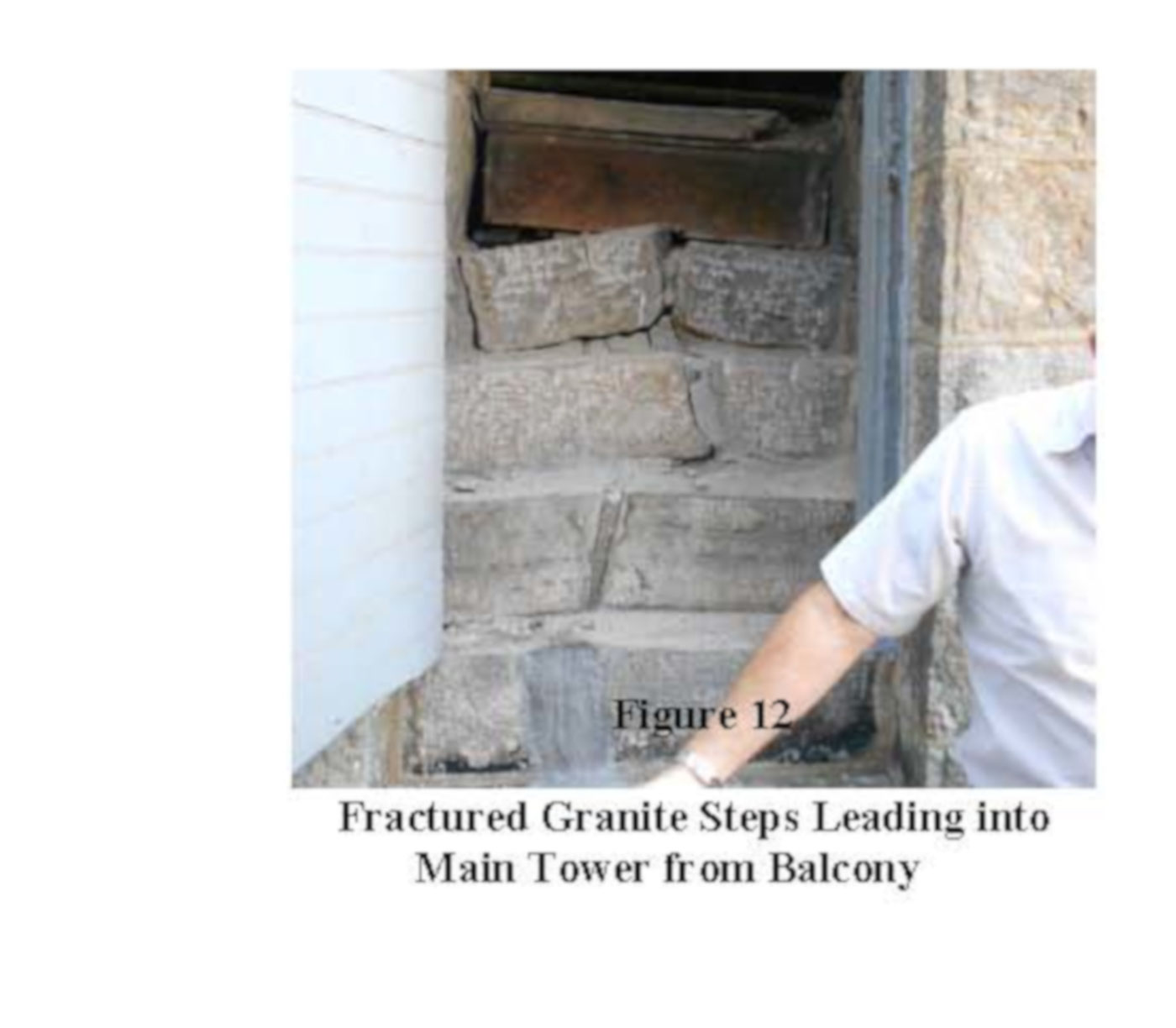
A photo included in a 2011 report by a Hamden architectural and engineering firm shows fractured granite steps between the balcony and the tower.
The firm concluded that the tower was structurally sound.
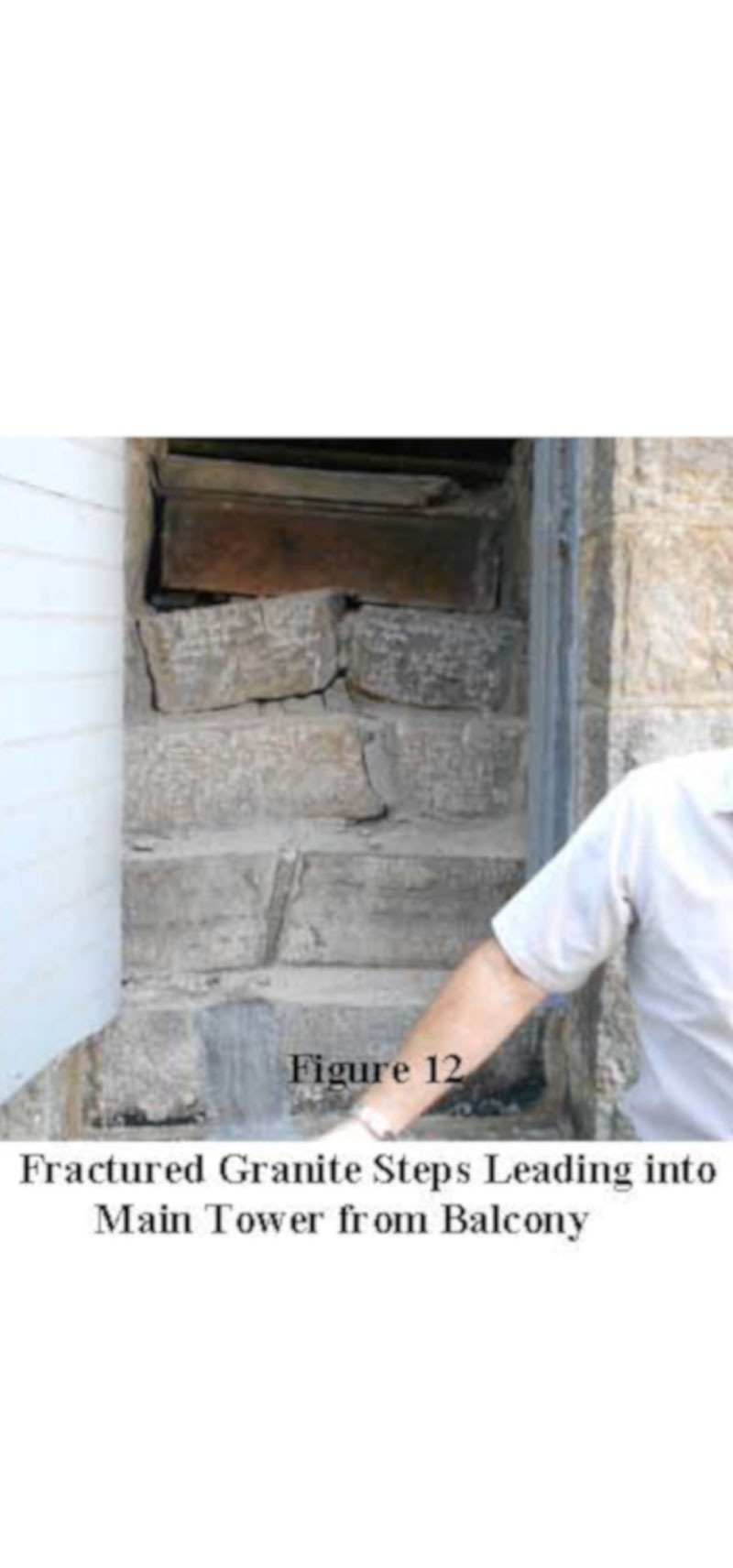
A photo included in a 2011 report by a Hamden architectural and engineering firm shows fractured granite steps between the balcony and the tower.
The firm concluded that the tower was structurally sound.
Bell noted that the report also mentioned damage in the area where he believes the crumbling masonry was but did not include a photo, which suggests there were no visible signs of structural cracks.
“The absence of those photographs probably means there was nothing glaring,” he said.
Except for the fractured steps, Bell said, he doesn’t know of much visible damage in the days before the collapse, making it hard to say whether there was any sign of imminent catastrophe.
“That’s what’s so terrifying about this,” he said. “You would like to know that the building was really shouting and screaming, giving everybody a warning, and they were ignoring it or whatever. …
“I think the lesson is that the warning signs are minimal. So the responsibility is to actually monitor buildings in different ways, pick up minor movements, and that’s the alarm bell to … come and check it out and keep the building safe.”
j.ruddy@theday.com
Comment threads are monitored for 48 hours after publication and then closed.


